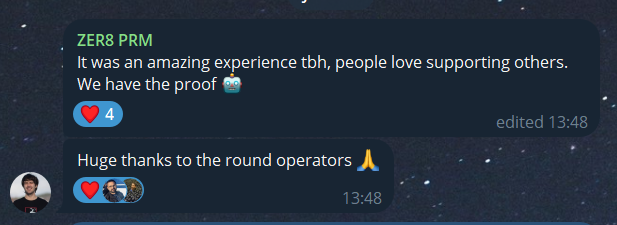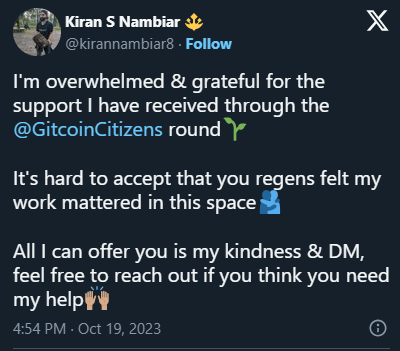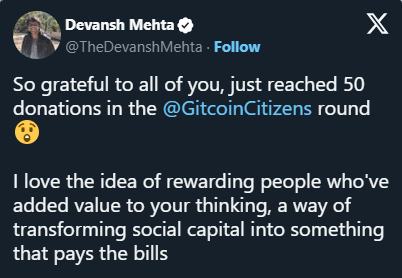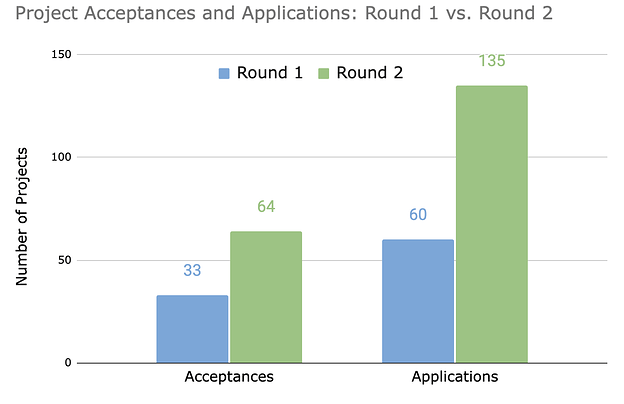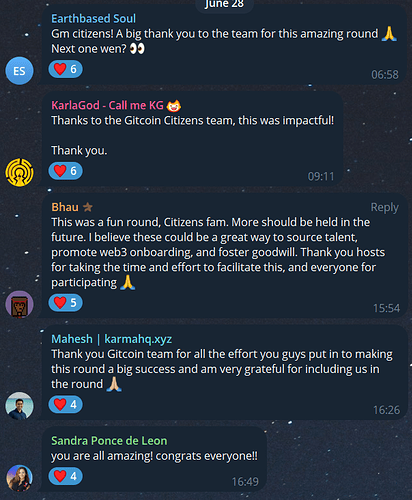GCP-004 Overall Learnings and Gitcoin Citizens Round #2 Results
Thank you to @krrisis for co-authoring this post with me and being my dependable partner in crime on the Gitcoin Citizens Round. Thank you also to @shawn16400 for helping us kick this off with the GCP and running round 1 and to @carlosjmelgar for stepping in to help run round 2.
TL;DR:
- We tested retroactive and proactive funding and felt more confident in the results of retroactive funding. We plan on sticking to this for future Citizens Rounds.
- We prefer funding individuals to projects because quadratic funding can be monopolized by big brand names with marketing reach.
- We saw massive growth in participating Citizens round-over-round as more people heard about the funding opportunity. Communities who wish to run similar rounds should try to plan to run two or more rounds from the get-go.
Intro
Following the end of Gitcoin Citizens Round #2, we have concluded our first GCP and are reporting back on our main results and learnings from the two rounds.
From the beginning, we set out to run an experiment. We wanted to understand:
- i) can quadratic funding be effectively used to build and support our own ecosystem?
- ii) can retroactive funding increase the effectiveness of quadratic funding?
The answer to both of these questions was a resounding yes, but not without deeper nuance. In this post we’ll briefly explore the lessons we learned from running two QF rounds for Gitcoin and the trade-offs we encountered.
Round Results
Here’s a quick recap of how the rounds went.
Gitcoin Citizens Round 1 was the first retroQF round, the first Grants Stack round to run on an L2 (Optimism), and the most successful Gitcoin Round to date in terms of crowdfunding versus matching. The crowdfund quadrupled the 20k matching pool and the round distributed over $100k to Gitcoin Citizens. You can read more in this case study and in our round 1 results post.
For Round 2 we invited our community to not only apply for retroactive funding but also submit planned work, as promised in our initial GCP. We also made Gitcoin history by distributing matching funding in our native token, GTC. We’re very happy with our results: 64 projects received $14,692 in donations from 1350 unique donors. In the process, they decided how we would distribute a matching pool of 22,232 GTC. Big thanks to @owocki who increased the matching pool by 50% by donating 4.20 ETH.
Can quadratic funding be effectively used to build and support our own ecosystem?
It is surprisingly easy to launch a QF round on Grants Stack in a few minutes. In the cGrants days (just 14 months ago), the only way to launch a QF round was to be a developer with backend access to our system. That is so different from today. Anyone can do it in a few clicks. Hats off to the incredible Allo team that lays the critical foundation and the Grants Stack team that makes it usable.
Now, on to the nuance.
Did quadratic funding effectively identify what should be built and supported within our own ecosystem?
This is really subjective. Here’s our personal stance: mostly no in round 1 and mostly yes in round 2.
When we initially kicked off the Gitcoin Citizens Round, it was after observing that there were many members of our community who were doing fantastic work and did not have a pathway to being funded for this work. We wanted to create that for them and also for anyone else who may come along. Those individuals (who we even specified as great examples in our proposal to run a Citizens Round) were: @jon-spark-eco, Carlos Melgar, and Carl Cervone. Unfortunately, they did not place close to the top of the Round 1 QF matching distribution.
Table 1: Top 5 projects by round
Was this because the community didn’t find their work valuable? No, if you ask many of the people at Gitcoin who have the highest-context then the work they did was universally incredibly valuable. However, what’s at play are the two biggest weaknesses quadratic funding faces in correctly determining where funds should go:
- Farmers & Attackers
- Grantee Awareness
Farmers & Attackers: Citizens Round 1 was Gitcoin’s first retroactive funding round and it ran on Optimism. Airdrop farmers were so hopeful! It was still surprising just how many showed up. Of the over 17k donors we know more than half were airdrop farming. In the process of farming the round they donated a lot of funding to Gitcoin community members but they also skewed the matching distribution.
Grantee Awareness: Given QF’s democratic/populist nature it’s difficult for lone individuals to compete with projects that hold as much brand recognition, marketing reach, or monogamously loyal supporters as Bankless or Biteye.
We took these lessons from Round 1 and adapted our strategy for Round 2. It’s also worth celebrating that, now, Jon and Carlos are Gitcoin Core and Carl is our largest external steward (by tokens delegated).
Moving into Round 2, we took a different approach. We decided to limit the eligibility to individual efforts and exclude team projects. We hoped this would reduce the ability of large brands to monopolize funding and more directly compensate those creating value. This ended up working well. The top projects in Citizens Round 2 are not only high-quality but the value they’re creating for Gitcoin is extremely tangible: from developing better QF algorithms, to building open grants funding databases, crafting our newsletter, cooking our dank memes, and even running our Citizens Round.
Our goal was to fund the people that create value for the Gitcoin Ecosystem. While more specific and tailored eligibility criteria certainly helped with this, it’s worth noting the following:
- a) We had clear examples of the types of grants we wanted to fund (essential to improving eligibility criteria)
- b) Our second round was much less attacked than our first one (in fact our number of unique donors declined 90% to 1350 – much more reasonable)
- c) We utilized cluster-matching QF which greatly mitigated the effect of a number of sybils and PGN airdrop-hopefuls while boosting the grantees who had diverse support.
Further analysis of the donors after payouts determined there were still some sybil attackers/airdrop farmers who received matching on their donation. Continuing to improve how we determine which wallets receive matching is extremely important to funding the projects which have authentic support.
There is likely also room to experiment with different methods of improving the quadratic funding outcomes, such as by encouraging or incentivizing the participation of our highest-context community members. One such experiment could involve airdropping Gitcoin core members funding with the express purpose that they use it to donate to the round.
Can quadratic funding be effectively used to build and support our own ecosystem?
One of the most telling indicators that the answer to this question is a yes is the increase we saw in builders. We received and accepted almost twice as many applications in Round 2 while decreasing our acceptance rate.
| Acceptances | Applications | Acceptance Rate | |
|---|---|---|---|
| Round 1 | 33 | 60 | 0.55 |
| Round 2 | 64 | 135 | 0.47 |
| Percent Difference | 93.94% | 125.00% | -14.55% |
Table 2: Project Acceptances, Applications, & Acceptance Rate, Round 1 vs. Round 2
It’s captivating to see so much growth RoR. One grantee told us “I only heard about the Citizens Round after Round 1 had ended” and another said that when they found out about the Citizens Round “It was in the middle of donations last time and I decided I’d apply to the next one.” We believe that continuing to run more rounds will continue to increase the quantity and quality of builders in the Gitcoin ecosystem.
One lesson for other communities is that you should probably try to run multiple rounds from the get-go. Your experience will likely be better because you’ll be able to iterate on eligibility criteria and more builders will be drawn to your ecosystem in round 2 after hearing about round 1.
It’s also worth noting the growth is accelerated by the diversity of acceptable contributions to our round. We did not limit the round to particular types of contributions such as open-source software or education. As a result, we were able to fund governance with Jengajojo, AI solutions such as Rohit with GrantsScope, community-building such as Cori at Regens Unite, and many more. We fund value creation for our ecosystem, whatever form it takes.
Can retroactive funding increase the effectiveness of quadratic funding?
As we stated in our initial proposal, we planned on running an experiment with our first two rounds. One fully retroactive round, with inspiration from Optimism’s RPGF, and one standard round.
Our first round, being retroactive, made it easy on us as reviewers to deny applications from those projects who hadn’t yet done anything.
We ran our standard round after our retroactive round. During this round, when reviewing both retroactive and proactive applications, we felt much more confident when admitting applications that already had work completed. We also felt much better about funding these submissions compared to those submissions that were requesting funding for work they might do.
One concern we had with retroactive funding and that drove us to also test a standard round was that not everyone can afford to work for free for an uncertain reward. Yet, as @ccerv1 pointed out on twitter: all funding is retroactive. All funding is based on work you’ve done before whether on this particular project or previous ones.
More practically, one way to lower the risk for builders would be to increase the cadence of the rounds. If someone works on something for three months and then does not receive adequate funding then this might really hurt them. On the other hand, if they work on it for 1 to 2 weeks and then receive a funding decision they can choose to keep working on it or move to something else. It’ll be important to test different cadences of rounds in the future. We believe there is a viable retroactive path for all.
Overall, for the above reasons, we plan on all future citizens rounds being fully retroactive. Further, given the market direction it may be worth it for the main Gitcoin Grants program to consider a shift to include one or more dedicated retroactive funding pools as well. This may then make it easier to raise funds for the matching pool due to the increase in funder confidence that they are funding impactful, valuable contributions to the ecosystem.
One notable memetic attractor in retroactive funding is ‘impact = profit’ which goes hand-in-hand with ‘fund the gap.’ In our Ccitizens Rround 2, we had individuals seeking retroactive funding for work that had been compensated previously. To adequately fund the gap, it’s essential that donors are paying attention to how much previous funding a grantee has received and that grantees are transparent about their prior funding. If Gitcoin doubles down on retroactive funding, then it’ll be important for us to consider how we surface the idea of funding the gap to voters (and draw attention to the necessary data). You can find some recommendations on this in our feedback to the product team in our initial documentation and more elaborately for round 2.
Closing
Thanks for making it this far.
We were surprised by how good it felt to fund retroactively and we were surprised by how good it felt to fund individuals instead of projects. It allows the community to much more directly determine who is creating value and send funds directly to them. It also sends a message to each Citizen that you choose what you want to work on, you don’t have to commit to a particular project: the rest of us will fund you if we find it valuable. This creates autonomy, freedom and a flat organization.
We view the Citizens Rounds as a model for our DAO, fostering a bottom-up, skills-driven owner’s mentality, bringing us back to the essence of what being a DAO is about. Our second GCP is coming very soon, and we’ll continue to check in with our community on missing pieces to achieve our goals, with a high focus on impact through retroactive funding.
Appendix
A. Relevant links:
Learnings product round 1 | Learnings product round 2
Results round #1 | Results round #2
B. Survey Results
| Round 1 | Round 2 | |
|---|---|---|
| Total Participants | 9 | 13 |
| Fairness of Compensation (3 = fair, 5 = over, 1 = under) | 3.11 | 2.62 |
| Felt Informed | 4.56 | 4.62 |
| Round Operator Rating | 4.56 | 5.00 |
| Intuitive to Set Up Grant Page | 3.56 | 4.23 |
| Intuitive to Apply For The Round | 4.11 | 4.54 |
| Intuitive to Bridge | 4.67 | 3.92 |
| Overall Experience / Satisfaction | 4.44 | 4.38 |
Table 3: Grantee Survey Results
When comparing Round 1 and 2 here are the most notable changes:
- Overall grantees felt more undercompensated in Round 2
- The experience of creating a grant and applying to a round was much more intuitive in round 2
- Bridging was much more intuitive in round 1 (on OP) than in round 2 (on PGN)
Full Survey Questions can be found here and here
C. Testimonials


